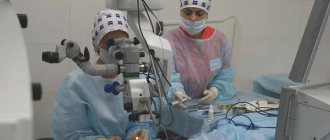Cataract is a degenerative disease of the eye lens, which results in first partial and then complete loss of vision. In 90% of cases, people with cataracts are elderly people. In 10% of cases it occurs in fairly young people and even children.
Rice. 1. Cataract
Rice. 2. Cataracts in a child
The causes of this serious illness are called:
- head and eye injuries;
- severe metabolic disorders (one of them is diabetes);
- radiation of various kinds (including long-term exposure to the unprotected retina of the eye from sunlight);
- age-related changes characteristic of the body of older people (these include a progressive decrease in the transparency of the lens in people over 60 years of age);
- infectious diseases and metabolic disorders in the mother's body during pregnancy (congenital cataracts in newborns).
As a result of any of these reasons, clouding of the lens begins. This process is caused by so-called protein denaturation in this organ. As a result, the lens of the eye loses its natural properties. Vision gradually becomes blurred. A person sees as if through a veil. The affected lens must be removed. It is replaced with a plastic implant - an IOL, or intraocular lens.
Rice. 3. Lens clouding
Rice. 4. Intraocular lens
What you need to know about the operation
There are now several types of cataract surgery. This:
- extracapsular extraction;
- intracapsular extraction;
- laser phacoemulsification;
- ultrasonic phacoemulsification.
All of them are just different ways of removing the lens affected by the disease. An operation called phacoemulsification is a kind of standard. It is the least traumatic for the patient, which allows to minimize the time of his postoperative rehabilitation. Literally 7-10 – in some cases less – days after surgery, a person can already lead his normal lifestyle, go to work, read, etc.
Depending on the equipment used during the operation, laser and ultrasound phacoemulsification are distinguished. Modern technologies make it possible to make a minimal incision (2-2.2 mm) and remove the affected lens through it. Then an intraocular lens is installed in its place. The entire operation lasts on average from 20 to 40 minutes. Anesthesia is usually local, or in rare cases (if there are no contraindications) general anesthesia is used.
Rice. 4. Extraction of the affected lens
Rice. 5. IOL placement
Contraindications and indications for surgery
The indication for surgical intervention is any degree and stage of cataract. It is especially recommended to perform surgery at the stage when the cataract is considered immature. At this stage, postoperative rehabilitation is faster and virtually without complications. If the patient comes to the clinic already at the stage of mature cataract, he will also undergo surgery. Modern techniques make it possible to restore the patient’s vision at this stage of the disease.
The situation is more complicated with the so-called overripe cataracts. This is the final stage of the disease, in which the fibers of the lens are completely destroyed, liquefy and become milky white. Surgery at this stage of cataract is also performed, however, it does not guarantee that the patient’s vision will be restored. Overripe cataracts are operated on mainly to save a person’s eye. The patient must be mentally prepared for this.
There are also contraindications that need to be taken very seriously. The following factors are an obstacle to cataract surgery:
- inflammation of any structure and tissue of the eye;
- the patient has an infectious or inflammatory disease of any other kind;
- neoplasms (oncology) in the area of the cataract-affected eye;
- the patient's age is under 18 years (this contraindication is conditional, since in some cases the doctor may decide to perform surgery on a younger patient).
Cataract stages and treatment
Cataracts are divided into several types (stages), depending on the effect on vision. There are 3 stages: initial, immature, mature.
Cataract surgery is possible at any stage. Most often, according to indications, they are performed at the stage of immature cataracts. At the initial stage, it is still possible to prevent the development of cataracts.
At the Eye Microsurgery Clinic (Ekaterinburg), qualified ophthalmologists conduct vision examinations to diagnose and monitor the condition of the lens at each stage of the disease, prescribe and carry out treatment and operations to replace the eye lens with an artificial one, and also monitor the state of vision after cataract surgery.
Cataract surgery
How is cataract surgery performed?
Types of artificial lenses
Cost of treatment and cataract surgery
The initial stage of cataracts and its treatment
At the initial stage of cataracts, clouding of the lens of the eye is insignificant and has almost no effect on vision. A person is practically unable to feel changes in vision at this stage; such clouding is usually detected at an appointment with an ophthalmologist.
For initial cataracts, conservative treatment is prescribed, which includes:
- Eye drops that improve nutrition of the lens.
- Hardware physiotherapy.
The purpose of these measures is prevention to slow the progression of the disease. In the initial stage of cataract, surgical treatment is usually not performed. The “initial” cataract may take 2-3 years, or many years. When an initial cataract is diagnosed, conservative treatment is regularly carried out, vision is checked and glasses are selected until they improve vision.
Clinic services
- Vision testing and selection of glasses for initial cataracts.
- Conservative, including hardware treatment.
- Prescribing eye drops.
Immature cataract and its treatment
At the stage of immature cataract, clouding of the lens of the eye is already pronounced, vision is significantly reduced. Despite the fact that a person still sees quite well, types of work related to looking at small details become almost impossible to perform, since the image looks like it is in a fog. Small and medium font in books and image details on TV are not visible, driving a car is quite difficult - it is difficult to see the road, especially at dusk and in the dark.
Conservative treatment of cataracts at this stage has no effect. At the stage of immature cataracts, vision can be improved in only one way - surgery to remove the cataract and replace the eye lens with an artificial one. The operation is performed microsurgically, quickly and painlessly. Depending on the individual characteristics of the eye, the doctor selects an artificial lens.
If you do not consult a doctor at this stage and do not have surgery, your vision will continue to deteriorate and the disease will progress to the stage of mature cataract. A timely operation will restore visual acuity and significantly improve the quality of life.
Clinic services
- Phacoemulsification operations with implantation of different types of artificial lenses (intraocular lenses - IOLs).
- Vision testing and selection of temporary and permanent glasses after cataract surgery.
Mature cataract and its treatment
At the stage of mature cataract, the lens of the eye is almost completely cloudy, and vision is almost completely lost. A person only sees the movements of the hand near the face and can determine the direction of the light source. Mature cataracts are rare today, because... Usually, when vision deteriorates, a person still at the stage of immature cataracts is offered and performed cataract surgery. The surgical techniques for removing the lens and implanting a new artificial lens (phacoemulsification or extraction), as well as the types of implanted artificial lenses, are the same as for immature cataracts.
Clinic services
- Phacoemulsification operations with implantation of different types of artificial lenses (intraocular lenses - IOLs). See list and cost below.
- Vision testing and selection of temporary and permanent glasses after cataract surgery.
Secondary cataract and its treatment
Secondary cataracts occur in people who have previously had cataract surgery. Secondary cataract is, in fact, not a cataract, because the cataract (i.e., the cloudy lens) was already removed during the first operation.
Secondary cataract is a clouding of the capsule left over from the old, cloudy lens, onto which a new artificial lens is installed after cataract removal. The capsule becomes cloudy in approximately 20-25% of operations performed: i.e. every 4-5th person after cataract surgery. The exact causes are still unknown, but for modern medicine, secondary cataracts are no longer a problem.
In 5 minutes, on an outpatient basis (no need to stay in the hospital), a hole is cut out in the center of the clouded capsule with a special laser - and vision is restored again. The operation is called YAG-discision of secondary cataract
- Surgery for laser treatment of secondary cataracts (performed using a YAG laser).
- Vision examination and selection of permanent glasses after secondary cataract surgery.
How is cataract surgery performed?
The purpose of cataract surgery is to replace the natural but cloudy lens of the eye with a new, artificial lens. The cloudy lens is removed using a special ultrasound device - a phacoemulsifier, through a small puncture-incision not exceeding 2.5 mm. A phacoemulsifier needle is applied to the lens. Under the influence of ultrasound, the lens is destroyed into very small fragments and aspirated (removed) from the eye. Through the same incision, a soft artificial lens of the eye (as it is also called, an intraocular lens - IOL) is introduced (implanted) into the eye. The operation itself is performed quickly and painlessly, using an operating microscope.
Cataract surgery
How is cataract surgery performed?
Cost of phacoemulsification for cataracts
Cost of artificial lenses
Types of artificial lenses
Artificial lenses are available both from foreign manufacturers - the USA, Switzerland, etc., and from Russia. The most commonly implanted are spherical, aspherical, toric, multifocal, and multifocal-toric artificial lenses. The lens is selected by the doctor and recommended depending on the patient’s vision parameters, his lifestyle and professional activities.
Types and features of artificial lenses
More about cataracts
Interview with the head physician of our clinic:
What tests to take before surgery
Any surgical intervention requires thorough preparation. This also applies to cataract removal. Whatever operation the patient undergoes, he is obliged to properly prepare for it and pass tests. Shortly before surgery, you need to obtain the results of the following studies:
- Blood test for 2 types of hepatitis: B and C.
- Blood test for RW.
- General blood test for prothrombin according to Quick, INR, platelets, fibrinogen, sugar level, etc.
- General urine analysis.
Attention! All this data is valid for no more than 1 month from the date of receipt, so it is recommended to take tests shortly before the operation. No earlier than 14 days before the start of the operation, it is necessary to do an electrocardiogram. Please pay attention to this requirement!
In addition, the patient must undergo fluorography (x-ray) of the chest. The data from this study is valid for a full year. If the patient has undergone fluorography for a year, he simply needs to take an extract about the results of this study.
Which doctors should you visit and what should you treat before surgery?
In addition to passing the listed tests, a patient preparing for cataract removal is required to undergo examination by the following specialists:
- endocrinologist;
- cardiologist;
- Laura;
- dentist;
- gynecologist (women), urologist (men);
- therapist;
- ophthalmologist;
- anesthesiologist.
Consultation with an endocrinologist is especially important if the patient has diabetes mellitus (any type). After receiving the results of electrocardiography, you need to consult a cardiologist and get his opinion. Visiting specialists such as ENT, dentist, therapist and gynecologist/urologist is necessary to identify the presence of any infectious and inflammatory diseases in the body.
A patient who is about to undergo cataract surgery needs to cure caries, sore throat, cystitis and any other infectious/inflammatory diseases. It is necessary to eliminate any source of infection that may adversely affect the course of the operation itself and the postoperative rehabilitation period.
Of course, a thorough examination by an ophthalmologist is mandatory. The doctor determines the stage of cataract development, the presence/absence of other diseases for which surgery is not possible. Other indicators necessary for successful surgical intervention are also determined (for example, the curvature of the cornea to select the type of implant).
It is also necessary to consult an anesthesiologist who will select the most appropriate anesthesia for the patient based on the age and physical health of the patient during the operation. There are no nerve endings in the lens of the eye, so the patient will not feel pain. To perform such a high-precision operation, the eye simply needs to be immobilized, and this requires anesthesia.
What to do on the eve of surgery
Before cataract surgery, you should not undergo strenuous physical activity. The patient should rest, sleep and gain strength. It is strictly forbidden to take any drugs or drinks containing alcohol. Alcohol, first of all! You should not eat anything the night before or the morning of surgery. The consumption of liquids should also be limited as much as possible.
You should be extremely careful when using medications. If the patient underwent some kind of treatment shortly before cataract surgery and is still taking certain medications, he must tell the doctor about this. 5-6 days before surgery, you should stop taking medications that have an anticoagulant effect on the body. It is not recommended to take aspirin! For all other medications, be sure to consult your doctor.
Cataract surgery is performed on an outpatient basis. The patient comes to the clinic, undergoes surgery, and can go home the same day. Before coming to the clinic, you should take a shower, wash your hair thoroughly, and put on comfortable cotton underwear. Be sure to take with you clean, replaceable shoes (comfortable slippers), a passport and all test results.
When is cataract surgery necessary?
Cataract is a pathology accompanied by clouding of the lens of the eye. Many people mistakenly believe that this does not pose any danger and treatment can be postponed. But, unfortunately, this is not the case.
Cataracts do not develop rapidly. Vision “falls” gradually and, in the end, the lens affected by cataracts finally loses its transparency, and the eye, accordingly, loses the ability to see.
Not so long ago, in order to achieve the best treatment results, it was necessary to wait until the cataract “ripened”, since its removal was recommended in the later stages. There were many reasons for this. For example, without a microscope, it was difficult to remove the lens in the early stages - because it remained quite transparent. Therefore, many still believe that there is no hurry. In fact, with developed cataracts, the lens thickens and increases in size , complicating the outflow of intraocular fluid. This, in turn, can provoke an increase in intraocular pressure and, as a consequence, the development of secondary glaucoma. Without surgical treatment, vision can be lost forever.
Secondary glaucoma is characterized by damage (atrophy) of the optic nerve with constant or periodic increased intraocular pressure, as well as a decrease in the visual field. It is important to remember that the optic atrophy that develops in patients with glaucoma is irreversible. That is, vision loss due to glaucoma is irreversible!
The development of a treatment technique, later called phacoemulsification, began in the mid-70s. More than 30 years have passed since then, and today we can say with confidence that ultrasound phacoemulsification with implantation of an artificial intraocular lens is the most effective, reliable, painless and modern method of cataract removal. When performing such an operation, folding intraocular lenses and viscoelastics are used to protect the internal structures of the eye; the ophthalmic surgeon performs all manipulations through a self-sealing micro-access.
Now patients do not need to wait for a convenient moment to undergo surgery. The earlier the disease is detected, the easier it is to treat and the better the result!
See also:
- All about cataracts: symptoms, treatment, surgery
- How is vision diagnostics performed at the Excimer Clinic?
- See the progress of cataract surgery
- How are cataracts and glaucoma related?
Preparation and progress of the operation
At the clinic, the patient may be given a mild sedative before being prepared for surgery. The skin around the eye is treated with a special bactericidal agent to prevent bacteria from entering the incision. The patient is then given anesthesia and covered with sterile drapes, leaving only the area of the eye that will be operated on free.
Local anesthesia is given by injection into the area around the eye being operated on. This is a completely painless procedure, as a result of which involuntary movements of the eyeball will stop. This will allow doctors to make a high-precision incision, remove the affected lens tissue and carefully implant an intraocular lens into the capsule.
Because the IOL is now made of very soft plastic, it folds easily. This allows you to insert the lens into the place of the removed lens through a micro-incision of 2 mm. This minimally invasive procedure does not cause any discomfort to the patient and promotes faster recovery after surgery.
It is extremely important to follow all the recommendations of the attending physician and take the medications prescribed after surgery strictly according to the prescribed schedule. This will ensure a faster recovery and increase the chances of successful vision restoration without complications.
Cataracts are not a death sentence! We tell you what “cataracts” are and how to treat them.
Cataracts are not a death sentence!
Unfortunately, there are diseases that can lead to vision loss if not taken care of in time. Cataract is one of them. This disease most often manifests itself in older age and does not respond to conservative treatment (drops and tablets). Irina Abramovna Sorokina, an ophthalmologist at the Optic Center clinic, talks about what cataracts are and how to help a patient with such a diagnosis.
What is a cataract and what are its symptoms?
Cataract is a clouding of the lens of the eye, which leads to a gradual deterioration of vision: at first, colors become faded, the contrast of objects decreases, black spots appear before the eyes, and it becomes difficult to read. Over time, the functions of the eye decrease more and more, and the person gradually loses vision.
Why does cataract develop and is it possible to prevent its occurrence?
In very rare cases, cataracts can be congenital, but in most cases, this disease develops with age, and anyone aged 45-60 years can experience it. The main reason for its development is age-related changes, and we are accustomed to talking about cataracts as a disease of the “elderly.” But, unfortunately, in recent years, younger active people aged 35-45 who are diagnosed with cataracts are increasingly coming to us. There are many reasons why the disease has become “younger”: irregular work hours, poor diet and lifestyle, sitting at the computer for many hours, unfavorable environmental conditions.
Therefore, ophthalmologists recommend that everyone who has reached the age of 35-40 undergo eye examinations at least once a year. Early diagnosis of cataracts will significantly speed up and simplify its treatment.
What to do if you are diagnosed with cataracts?
First of all, don't panic. Modern ophthalmology allows you to restore 100% clear and bright vision in most cases. But it is worth noting that conservative treatment, drops and tablets, cannot cure cataracts. Most likely, the disease will progress, and vision will deteriorate. Today, the only effective way is surgery. After the operation, a person regains good vision in a short time, sometimes even better than before the development of cataracts. A very important point, cataract is a disease that is much easier to operate in the initial stages. Leading doctors at our clinic are of the opinion that if you have a cataract at an early stage, you do not need to wait for its development; the sooner the operation is performed, the less traumatic it will be.
How is the operation performed? How safe is it?
During the operation, a micro-incision 2-3 mm wide is made and then, using ultrasound, the clouded lens is destroyed - its small fragments are mixed with a special solution and washed out of the eye. In place of the removed one, the surgeon installs a new artificial lens. The operation is absolutely painless and lasts about 20 minutes, performed under local anesthesia.
After the operation, the patient is under the supervision of a doctor for 1-2 hours and can then safely go home.
Another important and worrying question for many is: how quickly can I see well after the operation?
After the operation, the patient regains good vision within a few hours. Full recovery usually occurs within one month after surgery. After this, the patient can lead a normal lifestyle without any restrictions.
Where can such an operation be performed, and is there a waiting list for it?
The Optic Center ophthalmology clinic successfully deals with cataract problems - it has more than 2,500 successfully performed cataract extraction operations. There is no queue for surgery. You can receive treatment in the shortest possible period of time. If both eyes need to be operated on, the interval between operations is one week.
What determines the cost of the operation?
The cost of cataract extraction surgery depends on the model of artificial lens. It is selected for each patient individually, based on the results of the examination. Now at the Optic Center, cataract extraction costs from 25,000 rubles. We can offer patients both affordable options (“price-quality”) and more expensive premium ones. In addition, we specialize in complex multifocal lenses, which allow not only to get rid of cataracts, but also to completely restore vision, both near and far. After implantation of such lenses, a person can completely and forever give up glasses, which completely changes the quality of life.
Pay proper attention to your eyes - do not forget about regular vision tests and ophthalmological examinations. After all, it is easier to operate on cataracts at an early stage of development. Be healthy!
You can sign up for an examination through the website or by calling 8-800-775-78-58.
Ophthalmological clinic "Optic-Center"
G. Chelyabinsk, st. 40 years of October, 15
No. LO-74-01-002587 dated 03/12/2014











